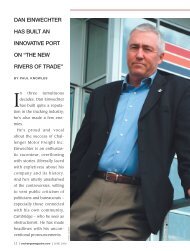Crosby Audi - Exchange Magazine
Crosby Audi - Exchange Magazine
Crosby Audi - Exchange Magazine
You also want an ePaper? Increase the reach of your titles
YUMPU automatically turns print PDFs into web optimized ePapers that Google loves.
Never Follow www.crosbyaudi.com<br />
<strong>Crosby</strong> <strong>Audi</strong><br />
1175 Weber Street East, Kitchener (519) 894-9300
sky’s THE the limit –<br />
VARIABLE DATA PRINTING HOLDS UNLIMITED<br />
POTENTIAL FOR<br />
UNLIMITED VARIATION<br />
IMAGINE THIS. Your company wants to use direct<br />
Imagine this.<br />
mail to tell your clients about a new product. Your marketing<br />
and promotion team is assigned to design a mailing<br />
piece, but when you visit their department, a few<br />
hours later, they are in turmoil. One person sees the<br />
potential of your product for young women; another<br />
believes it is ideal for middle-aged businessmen. Obviously,<br />
one brochure is not going to meet both those needs.<br />
Until now. You sit down and explain that there is new<br />
printing technology to solve this exact problem. One that will<br />
boost response rates on direct mail to previously unimaginable<br />
levels. You tell your team that a brochure can be designed<br />
and printed with dozens of variable fields – and each field can<br />
be designed to be exactly right for the client in question.<br />
A 22-year-old woman will receive a personalized mailer,<br />
addressed to her by name, outlining the product application just<br />
right for her life. A 50-year-old businessman will learn of the<br />
same product in a piece sent to him, by name, with the appropriate<br />
applications for him.<br />
Welcome to the era of variable data printing.<br />
MANY APPLICATIONS<br />
THE PRECEDING EXAMPLE is only one of an almost infinite number of<br />
applications that are possible with the development of variable data<br />
printing. This digital technology is a truly exciting development in<br />
the printing industry – and if you doubt the impact and level of<br />
enthusiasm, you should talk to the people at any one of the four<br />
printing companies in Kitchener, Waterloo and Guelph who are<br />
now offering the magic of variable data printing to their clients.<br />
Damian McDonald, of Ampersand Printing in Guelph, says the<br />
common reaction from clients is, “Wow!... People are excited<br />
about the applications and the possibilities.”<br />
Michael Litwiller, of Waterloo Printing in Waterloo, says “our<br />
customers are extremely happy with the results. They are<br />
whatever<br />
COLOUR<br />
you want it to be<br />
BY PAUL KNOWLES<br />
delighted with<br />
what we can do.”<br />
Peter Cober, of Cober Printing in Kitchener,<br />
reports that variable digital printing “blows them<br />
away. Until they see the product, they have no<br />
idea of the potential.”<br />
Erwin Driever, director of operations at Allprint<br />
Ainsworth Associates in Kitchener, says that the<br />
average response rate to a direct mail marketing program is 2-<br />
3%; “with variable data pieces, we are hearing of 23% to 27%.”<br />
VARIABLE DATA TECHNOLOGY<br />
VARIABLE DATA PRINTING is not brand-new. The technology has been<br />
showing up at printing trade shows for about seven years. But in<br />
the past year, commercial printers – including Allprint Ainsworth,<br />
Cober Printing, Waterloo Printing, and Ampersand – have come to<br />
the conclusion that it is now perfected, ready for their print shop<br />
floors, and all have made the investment to offer this dynamic<br />
new service, with its multitude of applications, to their clients.<br />
It is important to note that a similar application has been available<br />
using toner-based, photocopier technology, but the printing<br />
experts insist there is no comparison to the quality of the new,<br />
26 l exchangemagazine.com l JANUARY/FEBRUARY 2006
offset, ink-based digital press. Michael<br />
Litwiller makes the point: “This is certainly<br />
more than a colour photocopier.” A lot<br />
more, in fact.<br />
All four printing companies featured in<br />
this article are using HP technology for<br />
their variable data printing applications.<br />
And while personalized marketing pieces<br />
are certainly one of the most exciting<br />
uses of the printer, this is by no means<br />
the only important application. In fact,<br />
informational material from HP suggests<br />
no fewer than 37 separate applications<br />
of the HP Indigo or HP 5000, ranging<br />
through brochures, books and business<br />
cards to fine arts printing, outdoor signages<br />
and statements.<br />
Local print experts can talk enthusiastically<br />
for hours about the benefits of the<br />
new technology. Klaus Ertle, President of<br />
Allprint Ainsworth, notes that the new<br />
equipment facilitates applications ranging<br />
from a basic four-colour brochure<br />
through web-to-print, to full-scale variable<br />
data printing, “as small and tidy as you<br />
want or as large and challenging as you<br />
want it to be.”<br />
Peter Cober, owner of Cober Printing,<br />
points out that “short run colour is more<br />
affordable” on the unit, suggesting an<br />
example where a client wanted<br />
the same piece<br />
in English<br />
and French versions,<br />
with a shorter<br />
run in French. He<br />
referred to another<br />
job where a customer<br />
wanted 17 different<br />
covers on the<br />
same piece – you can<br />
do that more economically<br />
on a digital press.”<br />
Damian McDonald of<br />
Ampersand is excited about the full potential<br />
of digital printing. “This technology<br />
allows us to go further.” It permits completely<br />
Unlimited Unlimited applications<br />
applications<br />
to to variable variable data data printing printing<br />
THE POTENTIAL FOR VARIABLE DATA PRINTING is practically unlimited. This relatively<br />
new technology – in existence for about seven years, but available from four<br />
area printing companies only in the last 12 months or less – offers high quality<br />
digital printing with the enormous potential of variable data.<br />
All four local companies – Ampersand in Guelph, Waterloo Printing in<br />
Waterloo, Cober Printing in Kitchener and Allprint-Ainsworth in Kitchener – are<br />
using HP digital printers. Most have added equipment for bindery work and<br />
other post-press work, as well.<br />
The new technology is a big step up from the only previous option – tonerbased<br />
photocopier work of significantly lower quality than digital printing.<br />
Area printing professionals point to an array of applications for the new<br />
presses, including short run printing (as “short” as two booklets, in at least<br />
one case); print-on-demand (which is reducing the need for warehousing and<br />
eliminating wasted inventory), web-to-print applications, and the full potential<br />
of “versioning” and variable data printing which allows every piece of a run to<br />
be changed and individualized.<br />
HP suggests a wide range of applications for the new print technology, including:<br />
• Brochures – which can be tailored to<br />
individual recipients with multiple<br />
variable fields, including information,<br />
photos, illustrations, names, addresses<br />
– everything on the brochure can<br />
be changed from one piece to the<br />
next. This applies to all applications of<br />
the technology.<br />
• Banners<br />
• Books – especially appropriate for<br />
high-quality, short-run books; also<br />
effective for multiple covers.<br />
• Business cards<br />
• Calendars – which can be completely<br />
personalized.<br />
• Catalogs – variable fields allow<br />
individualization for each<br />
client in your<br />
data base;<br />
this allows<br />
“do it yourself” catalogs where customers<br />
can describe their purchase<br />
desires to an e-commerce vendor<br />
which then creates a custom catalog.<br />
• CD covers/booklets.<br />
• Certificates<br />
• Comic magazines, in which characters<br />
can actually be adapted to various<br />
cultural or religious sensitivities.<br />
• Contracts • Coupons<br />
• Direct mail - brochures, statements,<br />
company reports, catalogs, etc.<br />
• Fine arts printing • Flyers<br />
• Greeting cards<br />
• Insurance and benefit plans - customized<br />
to each client, with their<br />
individual data and contract details.<br />
• Leaflets • Letterhead<br />
• <strong>Magazine</strong>s • Manuals<br />
• Menus<br />
• Name tags<br />
• Newsletters • Office documents<br />
• Photo albums, generated from pictures<br />
provided by a consumer.<br />
• Photo ID cards • Postcards<br />
• Point of sale/display<br />
• Posters<br />
• Presentations<br />
• Product collateral<br />
• Proofs<br />
• Proposals<br />
• Short-run printing<br />
• Signage:<br />
indoor and<br />
outdoor<br />
• Statements/forms<br />
INDUSTRY SECTION l exchangemagazine.com l 27
individualized materials; each sheet printed<br />
can be different from the previous<br />
piece, changing names, paragraphs, illustrations,<br />
background, in fact the entire<br />
content of the piece.<br />
As Michael Litwiller, owner of Waterloo<br />
The highly computerized<br />
nature of the digital printing<br />
means all the prep work is<br />
done “off line”. Everything<br />
about the job – including<br />
sophisticated variables if<br />
Ampersand<br />
Ampersand<br />
Printing<br />
Printing<br />
MIKE MCDONALD FOUNDED AMPERSAND PRINTING, located at 123 Woolwich<br />
Street, Guelph, in 1975. He describes it as “a small shop which has grown<br />
over the years;” today, it has 22 staffers, including Vice President Damian<br />
McDonald, Mike’s son.<br />
The company was originally founded to print books, and while it still does<br />
some book printing, it is now a commercial print shop (marketing materials,<br />
catalogs, etc.), with a new and enthusiastic focus on digital printing. Damian,<br />
who brings considerable web-based experience to the job,<br />
believes digital printing will be a large part of the company’s<br />
focus. Already, digital printing<br />
has grown from zero in April, 2005,<br />
when the equipment arrived, to 25%<br />
of Ampersand’s output.<br />
Mike describes the company<br />
focus as “high quality... not that that<br />
means more expensive.” Many of<br />
their print clients are advertising<br />
agencies in the Guelph and<br />
K-W areas, and the McDonalds<br />
believe that these clients will very<br />
quickly grasp the benefits to their<br />
customers of variable data printing.<br />
“I see it building,” says Mike.<br />
“Customers are coming up with<br />
ideas and phoning us. It’s<br />
always our aim to partner with<br />
our customers.”<br />
Damian McDonald<br />
inventory wastage. They discovered<br />
that using digital printing would cost an<br />
additional $3 million annually. However,<br />
they also discovered that their existing<br />
system was producing $10 million in<br />
excess inventory each year, all of which<br />
was discarded as it became outdated.<br />
Going digital actually saved Hewlett-<br />
Packard $7 million annually, says Driever.<br />
In fact, print on demand can significantly<br />
decrease or even eliminate the<br />
need for clients to have warehousing for<br />
their print materials. Peter Cober notes<br />
that Cober Printing now supplies<br />
warehousing for some clients; the<br />
combination of those facilities and<br />
print on demand has eliminated<br />
the need for some customers to<br />
Printing, says, with “versioning” applications,<br />
“You can change anything you can<br />
imagine.”<br />
ECONOMIC ADVANTAGES<br />
THE ADVANTAGES IN TERMS of “individualizing”<br />
direct mail brochures, customer statements,<br />
and other promotional items are<br />
obvious. And the potential for web-toprint<br />
applications is enormous.<br />
However, every company offering variable<br />
digital printing agrees that, except for<br />
very short-run printing, it is more expensive.<br />
What is the economic gain for the client?<br />
The gain comes at the two ends of the<br />
process.<br />
First, the short-run capacity of the<br />
process is ideal for “print on demand.”<br />
required – is stored in<br />
servers. Printing additional<br />
pieces is simply a decision<br />
away. Mike Litwiller points out<br />
that once the computerized<br />
set-up is complete, it really<br />
doesn’t matter if you do “one<br />
copy or 5,000” on the variable<br />
data printer.<br />
More and more companies<br />
are realizing the economic<br />
advantages of print on<br />
demand – including the company<br />
that has supplied these<br />
digital print systems to all four<br />
local printers. According to Allprint<br />
Ainsworth’s Erwin Driever, HP analyzed<br />
their own printing patterns and<br />
(left to right) John James, Gail Moore and<br />
Bill Robinson of Ampersand Printing<br />
28 l exchangemagazine.com l JANUARY/FEBRUARY 2006
have their own warehouses.<br />
The other economic bang from digital<br />
printing comes with the incredible level<br />
of return on investment in well-designed,<br />
personalized marketing pieces. The printers<br />
we talked to agreed that traditional<br />
direct mail pieces usually produce a<br />
response rate of somewhere between<br />
1% and 3%.<br />
According to a variety of sources, the<br />
response rate to pieces produced using<br />
the full potential of variable data printing<br />
is phenomenal. Most experts begin by citing<br />
figures in the 15% to 20% range for<br />
response rate, but then even more dramatic<br />
success stories are told. Damian<br />
McDonald says, “I have heard up to<br />
37%” response rate.<br />
Todd Cober, of Cober Printing, talks<br />
about one client, a financial services institution,<br />
that used variable data printing to<br />
personalize client statements and include<br />
promotional material about a new product.<br />
The report is that 75% of recipients<br />
responded, requesting additional information<br />
or a meeting about the product.<br />
With that kind of response, any additional<br />
costs associated with the new<br />
technology are a non-issue, suggest the<br />
printers.<br />
The potential for producing materials<br />
targeted to individual recipients goes well<br />
beyond brochures and statements. Printers<br />
are already producing individualized<br />
catalogs, calendars, certificates<br />
and much more.<br />
ACCURATE DATA<br />
ONE KEY TO SUCCESSFULLY individualizing<br />
materials lies with the<br />
client – the data base must be<br />
accurate and up to date. If information<br />
about the person receiving the mailing is<br />
Waterloo<br />
Waterloo<br />
Printing<br />
Printing<br />
MICHAEL LITWILLER OWNS WATERLOO PRINTING, 235 Frobisher Drive, Waterloo.<br />
He is the second generation to be involved in the business – “My father, Walter,<br />
worked for Waterloo Printing for 30 years.” Michael joined the business 17<br />
years ago, and became owner in 1995.<br />
The company currently employs 21 people. Litwiller says while the staff size<br />
has remained constant for a number of years, the levels of production and<br />
efficiency have continually improved through adoption of new technologies,<br />
including variable data printing. “We’ve purchased the latest equipment,” he<br />
says, “and we are making our people as efficient as possible.”<br />
He describes his business as high quality commercial printing, including<br />
marketing and promotional materials, booklets, books, calendars...<br />
and much more.<br />
Some of these projects are now being produced<br />
using digital technology. Waterloo Printing has<br />
already produced variable data, digitally printed<br />
projects ranging from two copies – one in English,<br />
one in French – to “a run of 40,000 where we personalized<br />
everything.”<br />
Litwiller notes,<br />
Mike Litwiller<br />
“the equipment<br />
we’ve purchased is<br />
the best in the<br />
market. I can offer<br />
this with the<br />
quality they have<br />
been accustomed<br />
to.”<br />
wrong, then the mailing will be wrong,<br />
and the person will be significantly unimpressed.<br />
Erwin Driever<br />
stresses the<br />
importance of<br />
good data: “If the<br />
data is not right,<br />
you can cause<br />
damage,” he says.<br />
The client who<br />
orders the print<br />
job “has to be<br />
(left to right)<br />
Mike Litwiller and<br />
Ken Ferral of<br />
Waterloo Printing<br />
responsible to ensure that data is correct.”<br />
Ampersand’s Mike McDonald says,<br />
“The companies that are going to be successful<br />
are the ones who are going to<br />
have the data base on their customers.”<br />
Todd Cober agrees: “Having relevant<br />
and up to date data is very important.”<br />
Once upon a time, perhaps, printers<br />
were concerned only with producing an<br />
accurate copy of whatever the client<br />
ordered. Today, though, with the potential<br />
of the emerging technology, printers<br />
see their role as being much bigger<br />
than that. They will work with clients to<br />
be sure data bases are useful. They<br />
now have in-house design teams to<br />
develop the most effective ways for<br />
clients to use the new technologies.<br />
INDUSTRY SECTION l exchangemagazine.com l 29
Sales people are trained in up to the<br />
minute applications, because most<br />
clients are not even aware of the<br />
incredible potential for vastly improved<br />
ROI on their print promotions.<br />
WEB-TO-PRINT<br />
AND, AS NOTED ABOVE, clients also are excited<br />
about the potential of web-to-print<br />
applications. Variable data technology is<br />
the perfect environment for web-to-print.<br />
Printing customers can now go on line,<br />
big fan of variable data printing.<br />
He suggests that companies<br />
need to change their<br />
way of thinking about marketing,<br />
especially direct mail.<br />
Until now, a company would<br />
typically mail out, for example,<br />
50,000 pieces, blanketing<br />
a geographical area, and<br />
achieving a very low<br />
response rate. He admits that<br />
using variable data printing<br />
Cober<br />
Cober<br />
Printing<br />
Printing<br />
COBER PRINTING, at 965 Wilson Avenue in Kitchener, has been a family business<br />
since Vernon Cober founded the company in 1916. He was succeeded by his<br />
son, Lloyd. Lloyd’s son, Peter, is in charge today, joined by his son, Todd, and<br />
Peter’s sister, Billie Gural, her husband Tom and their daughter, Cara Knight.<br />
The business was founded to print flyers for Vernon’s corner store. It has<br />
come a long way, today occupying 46,000 square feet and employing 60.<br />
Peter says the company moved to its present location only<br />
five years ago, but growth has been greater than anticipated<br />
and already, says Peter, “It’s filling up.” The<br />
majority of Cober’s clients are in Ontario, while 25%<br />
to 30% of their business comes from the U.S.<br />
Peter describes Cober’s focus as “general commercial<br />
printing... higher end colour work.” He says the<br />
company has remained on the leading edge of technological<br />
innovation, and suggests this is a key to their<br />
success. That has led to Cober’s investment in digital<br />
printing, with a strong focus on web-to-print service, and<br />
anticipated growth of<br />
20% to 30% a year in<br />
digital printing.<br />
(left to right) Todd and Peter Cober of<br />
Cober Printing<br />
enthusiastically.<br />
His initial clients, he says, have been<br />
technologically sophisticated customers<br />
“who were fully aware of the capability<br />
that is there.” However, “very few people<br />
are aware of this,” he adds. “That’s the big<br />
selling job.” But Litwiller is confident that<br />
this is not a tough sell – once clients learn<br />
of the potential, they will be lining up to<br />
take advantage of all the benefits of variable<br />
data printing.<br />
Peter Cober<br />
and through the internet, design and<br />
order printed materials. They can upload<br />
their own material, or use variables of<br />
brochures and other templates that are<br />
offered by the printer, on line. Many use a<br />
combination of these approaches, design<br />
their own brochures, and order them. It is<br />
truly “web-to-print” – an effective use of<br />
the internet. Mike McDonald says the new<br />
technology “complements the web.”<br />
TARGETING CLIENTS<br />
L IKE ALL OF THE PRINTERS interviewed,<br />
Michael Litwiller of Waterloo Printing is a<br />
will cost<br />
more, per<br />
piece, but<br />
a s k s ,<br />
“wouldn’t<br />
it be<br />
better<br />
to contact<br />
3,000 or 4,000 people you<br />
really have a chance of selling to,” using<br />
material specifically “personalized” for<br />
each one? For Litwiller, the answer is obvious<br />
– and he notes that every client who<br />
has adopted this approach has agreed,<br />
BETTER THAN EMAIL<br />
DAMIAN MCDONALD of Ampersand believes<br />
variable data printing is not only an<br />
improvement on non-personalized<br />
print marketing, it<br />
is a great alternative to email<br />
marketing. “This technology is a less invasive<br />
means of getting information out,<br />
and making it relevant.” He also is an<br />
advocate of using the web to augment<br />
30 l exchangemagazine.com l JANUARY/FEBRUARY 2006
individualized print marketing, inviting<br />
clients to respond to personalized<br />
pieces via the web, which allows both<br />
collection of additional data, and tracking<br />
of response rate. He argues that “if<br />
you are using a website to measure<br />
response, you can refine your approach<br />
and try it again.”<br />
He contends that most companies<br />
today actually have the basic customer<br />
data they need – “Most people have it,<br />
whether they know it or not. This technology<br />
allows them to leverage it.”<br />
A MARKETING SOLUTION<br />
THE NEW TECHNOLOGIES available through<br />
printing companies and the interactivity<br />
made possible by the internet has significantly<br />
changed the relationship of printer<br />
and client, according to Todd Cober of<br />
Cober Printing. Today, “we are offering<br />
customers marketing solutions,” he says.<br />
That service, says his father, Peter, is<br />
based on a complete package, “from<br />
design to fulfillment.”<br />
And the solutions offered are almost<br />
unlimited in scope. Peter Cober refers to<br />
one 16-page piece that included “90<br />
areas of variability.” Todd points to the<br />
advantages of print on demand, which<br />
“gives the customers more options.”<br />
Those customers, says Peter, are<br />
increasingly aware of the options available<br />
to them, and are enthusiastic about<br />
the potential for variable data printing. In<br />
fact, he contends that not only is the<br />
technology now available, the time is also<br />
right because of “the maturing of the<br />
audience... people are recognizing the<br />
marketing value of their data base.”<br />
(left to right) Erwin Driever and Michelle<br />
Drexler of Allprint Ainsworth Associates Inc.<br />
Allprint<br />
Allprint<br />
Ainsworth<br />
Ainsworth<br />
Associates<br />
Associates Inc.<br />
Inc.<br />
KLAUS ERTLE FOUNDED ALLPRINT in 1976, after working in the printing business since<br />
the 1950s. He’s seen a lot of changes in the industry in almost half a century,<br />
including significant growth of his own share of print trade. Allprint, now located<br />
at 65 Hanson Avenue in Kitchener, acquired Ainsworth Press in 1993, and<br />
the company now has 82 employees and occupies a 50,000 square foot facility.<br />
That’s quite a change from Allprint’s first home on<br />
Courtland Avenue, a 4,000 square foot facility. The<br />
current plant is actually Allprint’s fourth location;<br />
consistent growth took it to a 16,000 square foot<br />
location in 1979, then to a 36,000 home in 1987,<br />
before moving to the present locale in 1993.<br />
Ertle describes his business mandate as<br />
“commercial printing”, including advertising<br />
materials, magazines, booklets, institutional publications,<br />
point of purchase materials... and a<br />
specialty of the house, distillery and<br />
winery labels.<br />
He characterizes the printing<br />
industry in the 21st century as<br />
one of “constant change... the<br />
rate of change has escalated.”<br />
Variable data, digital printing<br />
is one of the latest significant<br />
changes. Ertle estimates that<br />
digital printing will soon<br />
comprise 10% to 15% of<br />
the company’s<br />
business.<br />
Klaus Ertle<br />
CHANGE FOR THE BETTER<br />
ALLPRINT’S KLAUS ERTLE notes<br />
that the printing industry is<br />
one that faces “constant<br />
change... constant capital<br />
investment is required.” But<br />
from the perspective of his<br />
clients, he has no doubt that<br />
variable data printing is a<br />
change for the better.<br />
Erwin Driever says that Allprint’s<br />
focus, at the outset, is<br />
to identify customers who will benefit the<br />
most from the new technology. “We’re<br />
targeting specific clients who we know<br />
have a need for it.”<br />
But that list of clients will undoubtedly<br />
grow, as more and more customers<br />
recognize the incredible potential – from<br />
short-run, print on demand, to web-toprint<br />
efficiency to the almost magical<br />
potential of variable data applications –<br />
for their particular print communications<br />
needs. ■<br />
INDUSTRY SECTION l exchangemagazine.com l 31
You can stop calling it a<br />
“remote” office.<br />
With Atria Networks, external users and offices have instant access to corporate data,<br />
servers and centralized applications. Atria is unquestionably the fastest and most reliable<br />
connection to your employees, customers and suppliers. Our network offers unmatched<br />
regional Internet data services, with over 1000 kilometres of fibre-optic cable ready for<br />
customers in Guelph, Waterloo Region, and surrounding areas.<br />
www.atrianetworks.com<br />
FibreTech Telecommunications and Guelph FibreWired are now Atria Networks Inc.,<br />
a community-owned data communications company.<br />
Kitchener (519) 593-3000 Guelph (519) 780-1211

















